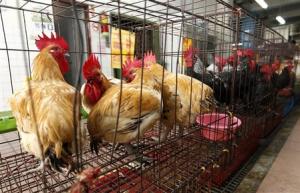Dutch scientists hidden away in a
top-security laboratory are seeking to create mutant flu viruses,
dangerous work designed to prepare the world for a lethal pandemic by
beating nature to it.
The idea of engineering viral pathogens to be more deadly than they are already has generated huge controversy, amid fears that such viruses could leak out or fall into the wrong hands.
But with China braced for scores more cases of a deadly new strain of H7N9 bird flu, Ron Fouchier and Ab Osterhaus say the benefits of this gene mutation research far outweigh the risks.
The experiments, designed to explore H7N9's potential to develop drug resistance and find which genetic modifications might enhance its ability to spread, could offer the know-how to halt a lethal flu pandemic, they say.
That could be with well-timed new vaccines or other therapies tuned to the pandemic strain's genes.
"We're bracing for what's going to happen next. If H7N9 becomes easily transmissible between humans, yes, the case fatality ratio may go down a little from where it is now, but we'd still be talking about millions of people dying," says Osterhaus, the head of a highly bio-secure laboratory in the Netherlands which will lead some of the H7N9 mutation work.
"This is a critical question - what does this virus really need to become transmissible? It is of extreme importance to being able to understand what's going on."
As things stand, 45 of the 136 people known to have contracted H7N9 bird flu in China and Taiwan have died - giving a case fatality rate of around 30 percent.
Fouchier, who has already done so-called "gain of function" experiments with another strain of bird flu, H5N1, says we need to get ahead of the game with H7N9 since its pandemic risk would rise "exponentially" if it gained in nature what he aims to give it in the lab - the ability to spread easily among people.
"OUTRAGEOUS CHUTZPAH"
So far, however, their drive to find out as much as they can about the genetics of bird flu risks rarely wins these world-renowned virologists thanks. More often, it elicits accusations of putting scientific self-interest over security.
Steven Salzberg, a professor of medicine and biostatistics from John Hopkins School of Medicine, accused them of "an outrageous display of chutzpah" and says Fouchier "is deeply confused about the possible benefits of this work", which Salzberg argues are marginal at best.
"The notion of 'gain of function' research on pathogens is very, very dangerous," he told Reuters.
The H7N9 outbreak, which began in February when the first cases of this flu strain previously unknown in humans emerged, flared up in April and May and dwindled over the summer months.
But news last week that a 35-year-old from China's eastern Zhejiang province is in a critical condition in hospital with the virus reawakened fears that it could come back hard as temperatures drop and the flu season returns.
So, hidden away in an un-signposted corner of the campus of the Erasmus Medical Centre in the port city of Rotterdam, a handful of top security-cleared researchers are selecting, deleting and adding genes to strains of the H7N9 virus to check what it might be capable of in a worst-case scenario.
The studies aim to genetically modify the virus to see what it needs to give it more of a deadly pandemic kick. That could mean making it more virulent, more pathogenic and, crucially, more transmissible - capable of passing easily in droplets through the air from one mammal to another.
Naturally, it's not the sort of work that can be done just anywhere.
The Erasmus team has one of Europe's most secure laboratories - a so-called Enhanced BSL3, or Bio-Safety Level 3, lab - the highest level of biosecurity for academic research and a facility in which agents can be studied that cause "serious or lethal disease" but don't ordinarily spread between people and for which treatments or preventives exist.
The highest level, BSL4, requires military guard and applies to pathogens for which there are no preventives or treatments.
SECURITY LAYERS
Fouchier, one of only six people with security clearance to enter the Rotterdam lab, says that despite the presence of mutant viruses, he feels safer there than walking in the street.
"You need special keys to get in. You go though various changes of clothes and through all sorts of interlocked rooms," he explained during a Reuters visit to the campus.
"There are personal pin codes and additional security measures to get through the next series of doors. And there are cameras all over the place, watching you all the time, 24/7."
Needless to say, media access to the laboratory itself is strictly forbidden.
Fouchier spent several years shuttling back and forth across the Atlantic arguing his case for conducting and publishing similar work on H5N1 bird flu, which so alarmed the U.S. National Science Advisory Board for Biosecurity (NSABB) that it took the unprecedented step of trying to censor publication.
The NSABB had said it feared details of the work could fall into the wrong hands and be used for bioterrorism.
A year-long moratorium on such research followed while the World Health Organisation (WHO), U.S. security advisers and flu researchers sought ways to ensure the highest safety controls.
With those in place, the WHO satisfied and U.S. research funders broadly agreed, Fouchier and 22 other scientists announced in August that they planned to end the moratorium, and the Dutch team say now is the time to get going.
The idea of engineering viral pathogens to be more deadly than they are already has generated huge controversy, amid fears that such viruses could leak out or fall into the wrong hands.
But with China braced for scores more cases of a deadly new strain of H7N9 bird flu, Ron Fouchier and Ab Osterhaus say the benefits of this gene mutation research far outweigh the risks.
The experiments, designed to explore H7N9's potential to develop drug resistance and find which genetic modifications might enhance its ability to spread, could offer the know-how to halt a lethal flu pandemic, they say.
That could be with well-timed new vaccines or other therapies tuned to the pandemic strain's genes.
"We're bracing for what's going to happen next. If H7N9 becomes easily transmissible between humans, yes, the case fatality ratio may go down a little from where it is now, but we'd still be talking about millions of people dying," says Osterhaus, the head of a highly bio-secure laboratory in the Netherlands which will lead some of the H7N9 mutation work.
"This is a critical question - what does this virus really need to become transmissible? It is of extreme importance to being able to understand what's going on."
As things stand, 45 of the 136 people known to have contracted H7N9 bird flu in China and Taiwan have died - giving a case fatality rate of around 30 percent.
Fouchier, who has already done so-called "gain of function" experiments with another strain of bird flu, H5N1, says we need to get ahead of the game with H7N9 since its pandemic risk would rise "exponentially" if it gained in nature what he aims to give it in the lab - the ability to spread easily among people.
"OUTRAGEOUS CHUTZPAH"
So far, however, their drive to find out as much as they can about the genetics of bird flu risks rarely wins these world-renowned virologists thanks. More often, it elicits accusations of putting scientific self-interest over security.
Steven Salzberg, a professor of medicine and biostatistics from John Hopkins School of Medicine, accused them of "an outrageous display of chutzpah" and says Fouchier "is deeply confused about the possible benefits of this work", which Salzberg argues are marginal at best.
"The notion of 'gain of function' research on pathogens is very, very dangerous," he told Reuters.
The H7N9 outbreak, which began in February when the first cases of this flu strain previously unknown in humans emerged, flared up in April and May and dwindled over the summer months.
But news last week that a 35-year-old from China's eastern Zhejiang province is in a critical condition in hospital with the virus reawakened fears that it could come back hard as temperatures drop and the flu season returns.
So, hidden away in an un-signposted corner of the campus of the Erasmus Medical Centre in the port city of Rotterdam, a handful of top security-cleared researchers are selecting, deleting and adding genes to strains of the H7N9 virus to check what it might be capable of in a worst-case scenario.
The studies aim to genetically modify the virus to see what it needs to give it more of a deadly pandemic kick. That could mean making it more virulent, more pathogenic and, crucially, more transmissible - capable of passing easily in droplets through the air from one mammal to another.
Naturally, it's not the sort of work that can be done just anywhere.
The Erasmus team has one of Europe's most secure laboratories - a so-called Enhanced BSL3, or Bio-Safety Level 3, lab - the highest level of biosecurity for academic research and a facility in which agents can be studied that cause "serious or lethal disease" but don't ordinarily spread between people and for which treatments or preventives exist.
The highest level, BSL4, requires military guard and applies to pathogens for which there are no preventives or treatments.
SECURITY LAYERS
Fouchier, one of only six people with security clearance to enter the Rotterdam lab, says that despite the presence of mutant viruses, he feels safer there than walking in the street.
"You need special keys to get in. You go though various changes of clothes and through all sorts of interlocked rooms," he explained during a Reuters visit to the campus.
"There are personal pin codes and additional security measures to get through the next series of doors. And there are cameras all over the place, watching you all the time, 24/7."
Needless to say, media access to the laboratory itself is strictly forbidden.
Fouchier spent several years shuttling back and forth across the Atlantic arguing his case for conducting and publishing similar work on H5N1 bird flu, which so alarmed the U.S. National Science Advisory Board for Biosecurity (NSABB) that it took the unprecedented step of trying to censor publication.
The NSABB had said it feared details of the work could fall into the wrong hands and be used for bioterrorism.
A year-long moratorium on such research followed while the World Health Organisation (WHO), U.S. security advisers and flu researchers sought ways to ensure the highest safety controls.
With those in place, the WHO satisfied and U.S. research funders broadly agreed, Fouchier and 22 other scientists announced in August that they planned to end the moratorium, and the Dutch team say now is the time to get going.
"The easiest thing would be to back off and say 'OK, we won't touch
this any more'. But that's not the right way to behave," said Osterhaus.
"As a scientist you have a responsibility towards the public. And if we
can prevent a pandemic from happening, that could save millions of
lives."



